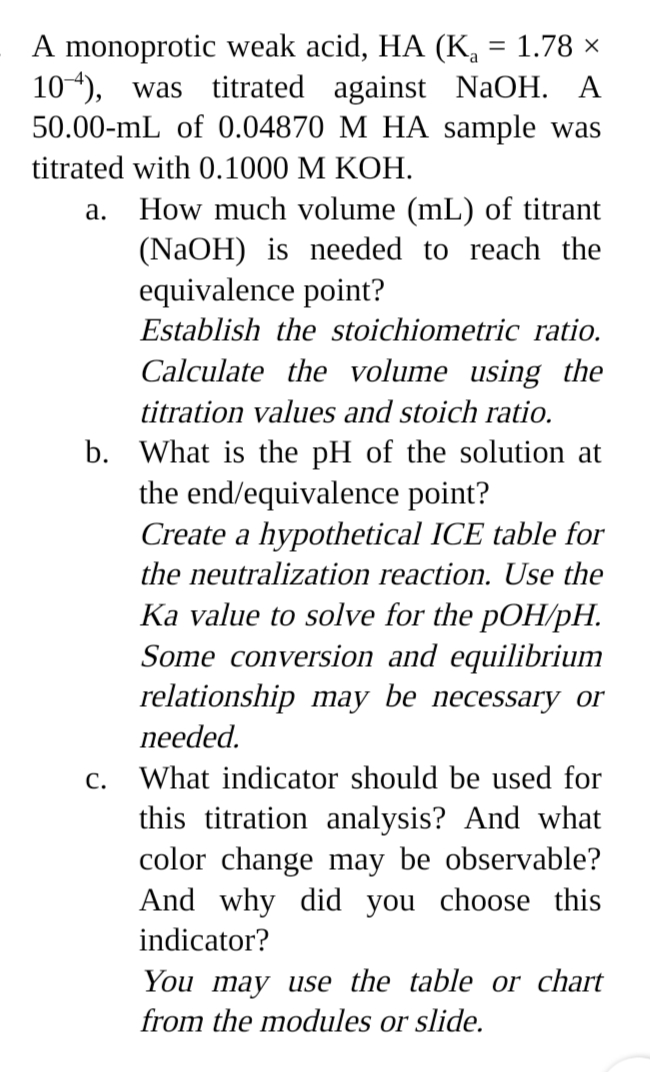A monoprotic weak acid, HA (K, = 1.78 × 104), was titrated against NaOH. A 50.00-mL of 0.04870 M HA sample was titrated with 0.1000 M KOH. How much volume (mL) of titrant (NaOH) is needed to reach the equivalence point? а. Establish the stoichiometric ratio. Calculate the volume using the titration values and stoich ratio. b. What is the pH of the solution at the end/equivalence point? Create a hypothetical ICE table for the neutralization reaction. Use the Ka value to solve for the pOH/pH. Some conversion and equilibrium relationship may be necessary or needed. С. What indicator should be used for this titration analysis? And what color change may be observable? And why did you choose this indicator? You may use the table or chart from the modules or slide.
A monoprotic weak acid, HA (K, = 1.78 × 104), was titrated against NaOH. A 50.00-mL of 0.04870 M HA sample was titrated with 0.1000 M KOH. How much volume (mL) of titrant (NaOH) is needed to reach the equivalence point? а. Establish the stoichiometric ratio. Calculate the volume using the titration values and stoich ratio. b. What is the pH of the solution at the end/equivalence point? Create a hypothetical ICE table for the neutralization reaction. Use the Ka value to solve for the pOH/pH. Some conversion and equilibrium relationship may be necessary or needed. С. What indicator should be used for this titration analysis? And what color change may be observable? And why did you choose this indicator? You may use the table or chart from the modules or slide.
Chemistry: Principles and Reactions
8th Edition
ISBN:9781305079373
Author:William L. Masterton, Cecile N. Hurley
Publisher:William L. Masterton, Cecile N. Hurley
Chapter14: Equilibria In Acid-base Solutions
Section: Chapter Questions
Problem 47QAP: A 0.4000 M solution of nitric acid is used to titrate 50.00 mL of 0.237 M barium hydroxide. (Assume...
Related questions
Question

Transcribed Image Text:A monoprotic weak acid, HA (K, = 1.78 ×
104), was titrated against NaOH. A
50.00-mL of 0.04870 M HA sample was
titrated with 0.1000 M KOH.
How much volume (mL) of titrant
(NaOH) is needed to reach the
equivalence point?
а.
Establish the stoichiometric ratio.
Calculate the volume using the
titration values and stoich ratio.
b. What is the pH of the solution at
the end/equivalence point?
Create a hypothetical ICE table for
the neutralization reaction. Use the
Ka value to solve for the pOH/pH.
Some conversion and equilibrium
relationship may be necessary or
needed.
С.
What indicator should be used for
this titration analysis? And what
color change may be observable?
And why did you choose this
indicator?
You may use the table or chart
from the modules or slide.
Expert Solution
This question has been solved!
Explore an expertly crafted, step-by-step solution for a thorough understanding of key concepts.
Step by step
Solved in 7 steps

Knowledge Booster
Learn more about
Need a deep-dive on the concept behind this application? Look no further. Learn more about this topic, chemistry and related others by exploring similar questions and additional content below.Recommended textbooks for you

Chemistry: Principles and Reactions
Chemistry
ISBN:
9781305079373
Author:
William L. Masterton, Cecile N. Hurley
Publisher:
Cengage Learning

Chemistry & Chemical Reactivity
Chemistry
ISBN:
9781337399074
Author:
John C. Kotz, Paul M. Treichel, John Townsend, David Treichel
Publisher:
Cengage Learning

Chemistry & Chemical Reactivity
Chemistry
ISBN:
9781133949640
Author:
John C. Kotz, Paul M. Treichel, John Townsend, David Treichel
Publisher:
Cengage Learning

Chemistry: Principles and Reactions
Chemistry
ISBN:
9781305079373
Author:
William L. Masterton, Cecile N. Hurley
Publisher:
Cengage Learning

Chemistry & Chemical Reactivity
Chemistry
ISBN:
9781337399074
Author:
John C. Kotz, Paul M. Treichel, John Townsend, David Treichel
Publisher:
Cengage Learning

Chemistry & Chemical Reactivity
Chemistry
ISBN:
9781133949640
Author:
John C. Kotz, Paul M. Treichel, John Townsend, David Treichel
Publisher:
Cengage Learning

Chemistry: Principles and Practice
Chemistry
ISBN:
9780534420123
Author:
Daniel L. Reger, Scott R. Goode, David W. Ball, Edward Mercer
Publisher:
Cengage Learning

Chemistry
Chemistry
ISBN:
9781305957404
Author:
Steven S. Zumdahl, Susan A. Zumdahl, Donald J. DeCoste
Publisher:
Cengage Learning
